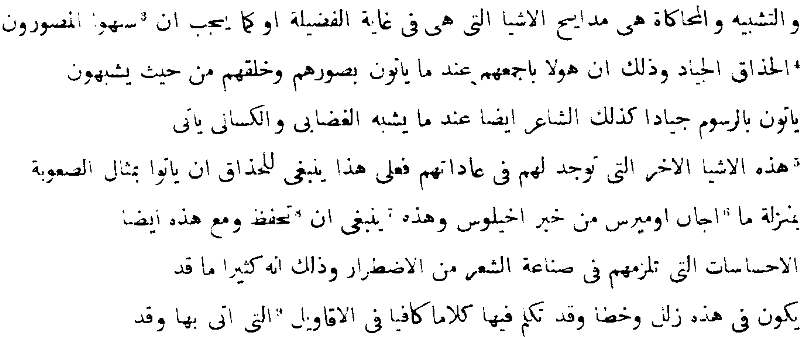Аристотель «Поэтика»: Замечание об их <3> похожести (1454b8)
Перевод М. Гаспарова
[b8] А так как трагедия есть подражание <людям> лучшим, <чем мы>, то мы должны брать пример с хороших портретистов, которые, изображая индивидуальные черты, делают <людей> похожими и в то же время красивее. [b11] Так и поэт, подражая <людям, страдающим> гневливостью, беспечностью и тому подобными недостатками характера, должен представить их такими, каковы они есть, и в то же время <людьми> достойными: так, пример <изображения> жестокосердия <представили в> Ахилле Агафон и Гомер.
[b15] Все сказанное <должны мы> иметь в виду, а кроме того еще и <погрешности> против ощущений, необходимо вызываемых поэзией, ибо и здесь бывает много ошибок; но о них достаточно сказано в изданных <наших> сочинениях.
Перевод В. Аппельрота
Перевод Н. Новосадского
Вот что следует иметь в виду, а также наблюдения над впечатлениями, неизбежно вызываемыми поэтическим произведением. Ведь и тут можно часто ошибаться. Относительно этого достаточно сказано в изданных мною сочинениях.
Translated by W.H. Fyfe
Keep, then, a careful eye on these rules and also on the appeal to the eye which is necessarily bound up with the poet’s business; for that offers many opportunities of going wrong. But this subject has been adequately discussed in the published treatises.
Translated by S.H. Butcher
Translated by I. Bywater
All these rules one must keep in mind throughout, and further, those also for such points of
Traduction Ch. Emile Ruelle
XI. II faut observer avec attention ces divers points et, en outre, ce qui s’adresse aux sens dans leurs rapports nécessaires avec la poésie , car on peut faire souvent des fautes à cet égard; mais nous nous sommes suffisamment expliqué
